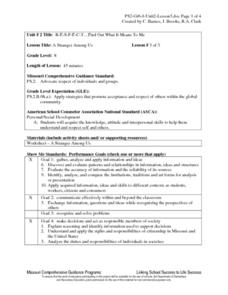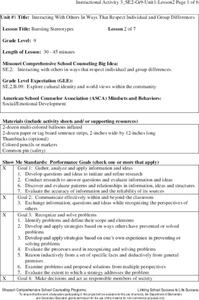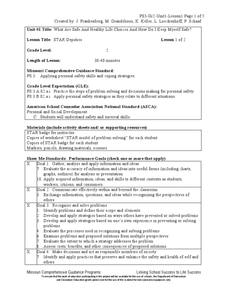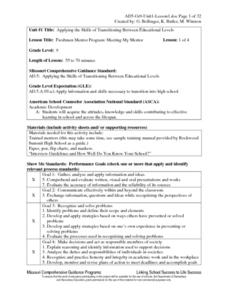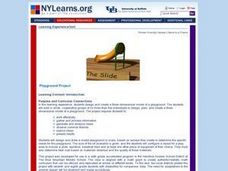Curated OER
Mark Twain and Huckleberry Finn Introductory Lessons
“What is the role or function of controversial art? And, should children, our children, be required—forced—to study certain works they may find painful or humiliating or offensive?” Robert Zalisk’s question, found in his article, “Uproar...
Curated OER
A Stranger Among Us
Eighth graders give their own definition to the terms race, religion, culture, character and ethnicity and write them on the board. As a class, they discuss the differences and similiarties between the terms. In groups, they complete a...
Missouri Department of Elementary
Bursting Stereotypes
Balloons take on the role of stereotypes in an activity that asks high school freshman to generate a list of different adjectives that are frequently used to describe men and women. Then then attach a stereotypical label to a balloon and...
Curated OER
STAR Deputies
Second graders engage in a instructional activity that is about the sharing of following rules to follow the law. They concentrate on the making of safe choices. Students use the examples to have class discussion. They also role play...
Curated OER
Bursting Stereotypes
Ninth graders discuss the importance of respecting others. After popping balloons, they use paper strips to write words representing stereotypes for men and women. In groups, they share their list and identify those that could be used...
Curated OER
Freshmen Mentor Program: Meeting My Mentor
Students develop skills that address the transition from middle to high school. They take part in a series of activities that help them to become more comfortable in their new social setting.
Curated OER
Graduation Requirements
Ninth graders make decisions, set goals, and take necessary action to achieve goals. They review their school course descriptions book. Students review the graduation requirements from the book. They are given an handout "Graduation...
Curated OER
Alcohol and Marijuana "Gateway Drugs"
Ninth graders use the internet to research the effects of alcohol and marijuana. They present strategies for resisting peer pressure.
Curated OER
The Significance of the Buffalo
Students discuss the significance of the buffalo in their Native American community. They interview elders and take a field trip to a buffalo pasture. They conduct research in the library about how the buffalo was used in the...
Curated OER
Colonial Regions of America 1689 - 1754 Worksheet
In this Colonial America worksheet, students color and label a map of the 13 colonies. They complete three more maps on which they label the major cities and waterways in New England, the Middle, and the Southern colonies. They answer an...
Curated OER
Five Paragraph Essays
Students can learn important writing skills, such as how to complete a five paragraph essay, with these lessons.
Curated OER
Math: Designing a Playground
Sixth graders design and draw a model playground to scale. They configure the layout to include a sandbox, slide, baseball field and other equipment. Their design includes adaptations for students with disabilities. Their designs are...
Curated OER
An Introduction to GPS
GPS is a technological tool that has become available for use by the general public. Navigate the components and science involved in this remote sensing system. Here is a comprehensive collection of slides that would be valuable to share...
National History Day
“War Is Hell. We Know it Now.” American Soldiers in the Meuse-Argonne Offensive
Understanding the soldier's experiences during World War I sometimes takes a newscast. Learners see the importance of understanding multiple points of view with a newscast project surrounding the Meuse-Argonne Offensive. Compare and...
Curated OER
History Fair
Students create a History Fair. They examine the National History Day Competition and are encouraged to participate.
Curated OER
Animals Galore
A well-designed lesson which covers the characteristics of the animals found in the six animal groups is here for your young biologists. In it, learners divide up into six groups; the amphibians, reptiles, mammals, birds, fish, and...
Curated OER
A Walk on the West Side
Students comprehend what makes up the physical community. Read and construct scale drawings and models. Explore the history of infrastructures and how the contributions of science, math and industry have led to the development of their...
Curated OER
Neighborhood or Slum? Snapshots of Five Points: 1827-1867
How has your local neighborhood changed throughout recent history? Young researchers evaluate census data, images, and primary source descriptions describing the living situation in the antebellum Five Points neighborhood. They consider...
Tennessee Technical University
Carousel Brainstorm
A variation of the Walkabout Review process, carousel brainstorming directs groups to rotate through a series of stations posting ideas on the topic or question posted at each stop.
Curated OER
The Anxiety Workbook For Teens
Teens often face a great deal of worry in their lives, and can be at a loss with how to anticipate and handle their emotions. This workbook is an exceptional resource for both educators and students alike as a way of supporting...
California Department of Education
Plagiarism is Stealing!
Stop, thief! Do your pupils understand the consequences of plagiarism? Lesson three of six in a series of college and career readiness activities demonstrates the dangers of taking credit for someone else's work. Learners engage in...
Florida Center for Reading Research
Dictionary Cube
Young scholars investigate new vocabulary words with a fun, collaborative activity. Given a deck of word cards, pairs of students flip over one at a time and independently look up the term in a dictionary. They then take turns rolling a...
Curated OER
There's Omegas in Those Hemp Seeds
A very well-designed lesson plan focuses on the many benefits of Omega Fatty Acids. Learners read some articles on omega fatty acids, then access a glossary that is included in the plan. They fill in terms along with their definitions....
Curated OER
Where Were Your Ancestors in 1871?
Here is a nicely designed lesson plan on ancestry and family history. In it, learners read an article entitled, "Where Were Your Ancestors in 1871?" Then, they make up a series of questions to profile their family and their community 100...

